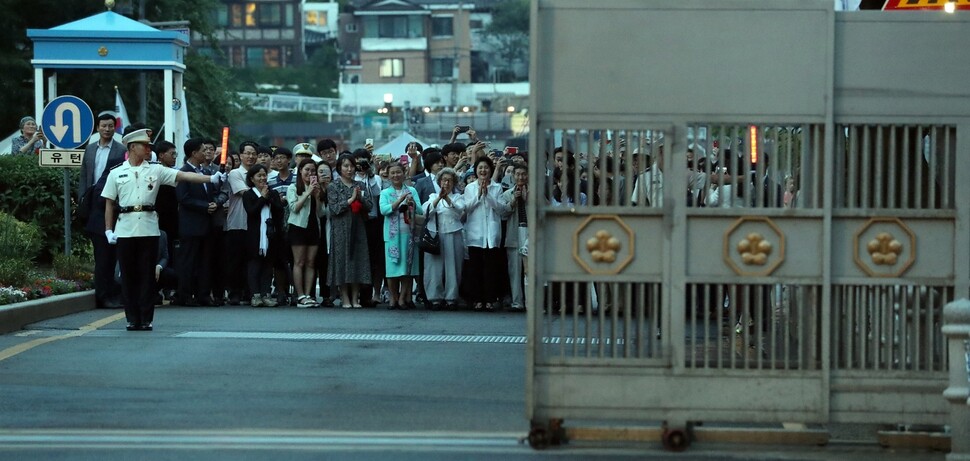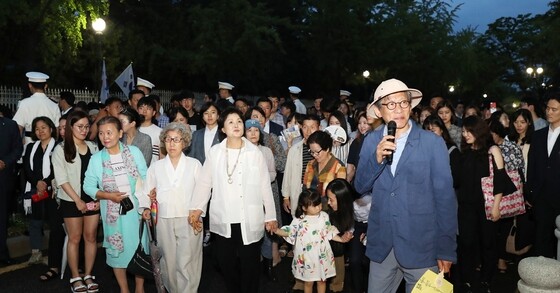hankyoreh
Links to other country sites 다른 나라 사이트 링크
Blue House road opened at night for first time since 1968

At exactly 8 pm on June 26, Blue House assistant spokesperson Koh Min-jeong and a crowd of people counted down from five to one in front of the Blue House press center, called Chunchugwan (Spring and Autumn Pavilion). As the iron gate that had been blocking the road in front of the Blue House opened, the crowd cheered. More than 200 people attended the event at which the road in front of the Blue House was opened up at night for the first time in 49 years. “This is such a relief,” one said. “A new era has come,” said another.
After the heavy iron gate opened, 50 Koreans who had applied in advance on social media walked down the path from Chunchugwan to Sinmu Gate at Gyeongbok Palace in the company of First Lady Kim Jeong-sook, 63, and Yu Hong-jun, supervisory chair of the Gwanghwamun Presidential Pledge Strategy Committee. “This place used to be silent because no one was allowed here after 8 pm, but I like how full of energy it is today. It‘s a small change, but I’m glad we‘re giving the people back the roads and plazas that the government had blocked off,” Kim said from a temporary stage set up in front of Sinmu Gate. The participants applauded and chanted words of encouragement for President Moon Jae-in.
The road in front of the Blue House, which has been closed at night since the North Korean commando raid on the Blue House in 1968, is open to the public 24 hours a day as of June 26. The section that is being opened up is Blue House Street, which runs from Chunchugwan on the east to the plaza and fountain in front of the main entrance to the Blue House on the west. The road had only been open from 5:30 am (6 am in the winter) until 8 pm, for security reasons.

One of the people going for a stroll that evening was Choi Jun, 41, who, as a resident of the Samcheong neighborhood of Jongno District, is one of the Blue House’s neighbors. “The Blue House used to have a mysterious and gloomy air to it. I think the opening is significant since it brings access to a historical space,” Choi said.
“I came for the opening ceremony with my colleagues in the democratization movement. I had come to the area several times before because of my curiosity about the Blue House, but every time I was stopped by security. It’s touching and feels like a burden has been lifted to be able to set foot here for the first time,” said Jang Gwi-seok, 68, who lives in Goyang, Gyeonggi Province.
During the press briefing at Chunchugwan on June 22, Blue House spokesperson Park Soo-hyun said that opening the road in front of the Blue House was “one of the measures designed to make the Blue House more open. Now that members of the public are free to walk around Gyeongbok Palace at night, we hope that this will become one of Seoul’s distinctive walking courses.”
The police security checks, which had inconvenienced visitors even when the street was open to the public, have also been relaxed. At 5:30 am on June 26, police officers went out in the rain to remove the five mobile security scanners around the Blue House. All that is left now is a traffic checkpoint. Aside from a few security facilities, the restrictions on taking pictures of the area around the Blue House from the summit of Inwang Mountain have been relaxed as well. “The president is going to become someone who associates with and serves the public, since they are the sovereign rulers of this country,” said an official in the Blue House Office of Security.
The road in front of the Blue House was completely blocked off until Feb. 1993, when it was first opened to the public (but not at night) as part of former president Kim Young-sam’s (1993-98) policy of tearing down authoritarianism.
The opening of the street is likely to lead vocal citizens to visit the area in front of the Blue House more frequently. Even in Feb. 1993, when the street in front of the Blue House was partially opened, the area in front of the Blue House became a site for demonstrations. There were over 600 group demonstrations in front of the Blue House in 1993, a major increase from the seven held in 1992, the media reported at the time.
Those 1993 trends are being repeated in 2017. The Korean Confederation of Trade Unions (KCTU), which has announced a general strike on June 30, has already set up a tent within 100 meters of the entrance to the Blue House and is protesting for working hours to be shortened and for the Korean Teachers and Education Workers Union (KTU) to be recognized as a legal union.
“There have been major improvements in this country’s security capabilities. The Blue House’s current security apparatus is fully capable of handling various risk factors that could occur,” said an official from the Office of Security when asked about security concerns.
By Heo Jae-hyun and Jung Yu-gyung, staff reporters
Please direct questions or comments to [english@hani.co.kr]

Editorial・opinion
![[Editorial] Yoon must halt procurement of SM-3 interceptor missiles [Editorial] Yoon must halt procurement of SM-3 interceptor missiles](https://flexible.img.hani.co.kr/flexible/normal/500/300/imgdb/child/2024/0501/17145495551605_1717145495195344.jpg) [Editorial] Yoon must halt procurement of SM-3 interceptor missiles
[Editorial] Yoon must halt procurement of SM-3 interceptor missiles![[Guest essay] Maybe Korea’s rapid population decline is an opportunity, not a crisis [Guest essay] Maybe Korea’s rapid population decline is an opportunity, not a crisis](https://flexible.img.hani.co.kr/flexible/normal/500/300/imgdb/original/2024/0430/9417144634983596.jpg) [Guest essay] Maybe Korea’s rapid population decline is an opportunity, not a crisis
[Guest essay] Maybe Korea’s rapid population decline is an opportunity, not a crisis- [Column] Can Yoon steer diplomacy with Russia, China back on track?
- [Column] Season 2 of special prosecutor probe may be coming to Korea soon
- [Column] Park Geun-hye déjà vu in Yoon Suk-yeol
- [Editorial] New weight of N. Korea’s nuclear threats makes dialogue all the more urgent
- [Guest essay] The real reason Korea’s new right wants to dub Rhee a founding father
- [Column] ‘Choson’: Is it time we start referring to N. Korea in its own terms?
- [Editorial] Japan’s rewriting of history with Korea has gone too far
- [Column] The president’s questionable capacity for dialogue
Most viewed articles
- 1Months and months of overdue wages are pushing migrant workers in Korea into debt
- 2Trump asks why US would defend Korea, hints at hiking Seoul’s defense cost burden
- 3At heart of West’s handwringing over Chinese ‘overcapacity,’ a battle to lead key future industries
- 4[Editorial] Yoon must halt procurement of SM-3 interceptor missiles
- 5[Guest essay] Maybe Korea’s rapid population decline is an opportunity, not a crisis
- 6Fruitless Yoon-Lee summit inflames partisan tensions in Korea
- 7Dermatology, plastic surgery drove record medical tourism to Korea in 2023
- 8First meeting between Yoon, Lee in 2 years ends without compromise or agreement
- 91 in 3 S. Korean security experts support nuclear armament, CSIS finds
- 10AI is catching up with humans at a ‘shocking’ rate